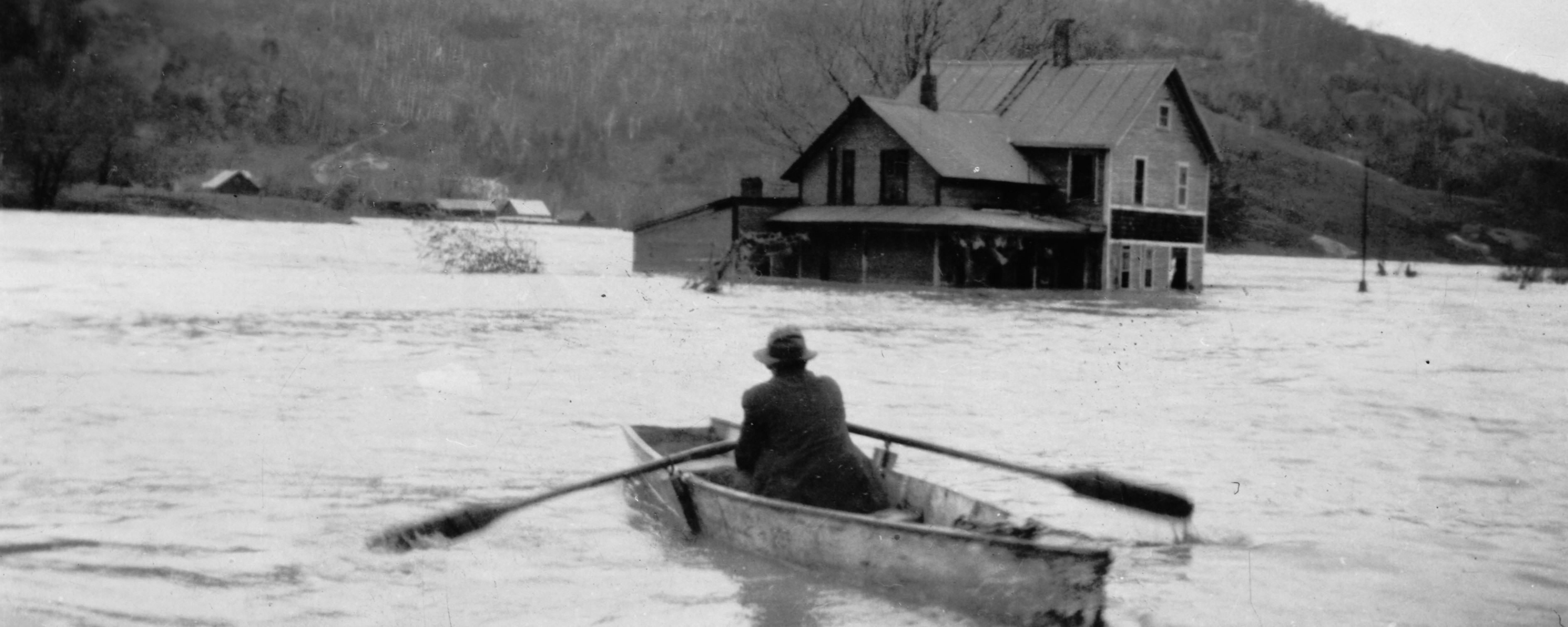The Flood of '27, 1927

Oral history transcriptions
Click a name below for more information. All transcripts are in PDF format.
Background information
Vermont has had a long history of flooding. Of its approximately twenty major floods in the last two hundred years, the flood of November 3-4, 1927, was one of the most devastating (rivaled, and perhaps exceeded, by the floods in May 2011 in Central Vermont and the widespread damage from flooding related to Tropical Storm Irene in August 2011). A severe rainfall had swept across all of New England on that November weekend. But when the deluge hit Vermont, the state’s soil had already become saturated and the streams were running full because of an unusually heavy precipitation in late summer and fall.
The rain began at 10 o’clock on the evening of November 2, and continued until 11 a.m., November 4. The heaviest rain came during the afternoon and evening of November 3, when more than seven inches fell in a six-hour period. It was on that evening that the flood reached its height. The downpour, which went almost immediately into the river systems scattered through the state’s narrow and low valleys, was more than the watercourses could handle. Brooks overflowed and rivers became torrents, carrying trees and logs in their wake. Rivers reached 13 feet or more above their normal depths. Dams, bridges, and embankments were swept away. Towns and villages located along the rushing streams were engulfed. Factories submerged, farm animals drowned, and homes and barns were destroyed. As the water gradually receded, it left behind a trail of eroded farm land; layers of silt, gravel, and debris; and disorganized towns. In Montpelier, which was especially hard hit, at least a foot of mud was left on floors of downtown stores.
The 1927 flood is generally considered the worst natural disaster in the state’s history (in terms of loss of property, the 2011 floods are still being assessed). The list of dead totaled 84, with 55 lives lost in the Winooski River basin alone. In Bolton, 19 in one boarding house drowned when the Bolton Valley Dam broke. The loss to 23 manufacturing plans was $2,812,500. In Montpelier, where only two stores carried flood insurance, the staggering loss totaled an average of $400 for every man, woman, and child in town. The State of Vermont estimated that a total of 1,258 bridges were destroyed or severely damaged, and that the total damage to the state’s highways and bridges amounted to $7,755,000. Total damage in the state resulting from the flood was estimated a $35,000,000 (approximately $439,000,000 in 2010 dollars—see MeasuringWorth.com).
In the days following the flood’s abatement, Vermont was widely praised for its recovery efforts. President Calvin Coolidge, in particular, hailed the “indomitable spirit” of Vermonters who found strength within themselves and sought help from no one in meeting the adversity. However, Samuel B. Hand in 1987 and Deborah and Nicholas Clifford in 2007 have taken issue with the widely held impression that Vermont’s efforts at recovery from the flood’s destruction were spearheaded by individual acts of traditional Vermont-style self-help and ruggedly independent action without the aid of outside and especially federal assistance and funds. Hand and the Cliffords argue that the enormity of the task faced by communities in rebuilding town roads and bridges necessarily caused the most significant recovery efforts to be acts of the state government, financed by a combination of state and federal revenues. State-directed recovery efforts, they maintain and demonstrate, produced at least two effects of long-term importance: 1) the emphasis on state control of recovery activities and the de-emphasis of traditional local autonomy contributed importantly to the growth of the state bureaucracy; and 2) the reconstruction of Vermont’s highway system with hard-surfaced roads greatly accelerated the arrival in Vermont of the age of the motor vehicle. The Cliffords argue, in addition, that the events of 1927 were a prelude to larger economic, social, and cultural changes of the 1930s and beyond.
—Gene Sessions
For further reading:
Deborah Pickman Clifford and Nicholas R. Clifford, “The Troubled Roar of the Waters”: Vermont in Flood and Recovery, 1927-1931. (Durham, N.H.: University of New Hampshire Press and University Press of New England, 2007).
Samuel B. Hand, “Potholes and Watersheds: Perspectives on 1920-1960,” in Lake Champlain: Reflections on Our Past, ed. Jennie G. Versteeg (Burlington, Vt.: Center for Research on Vermont, University of Vermont, 1987): 21-32.
Michael Sherman, Gene Sessions, P. Jeffry Potash, Freedom and Unity: A History of Vermont (Barre, Vt.: Vermont Historical Society, 2004): 421-432.
Citation for this page
Woodsmoke Productions and Vermont Historical Society, “The Flood of '27, 1927,” The Green Mountain Chronicles radio broadcast and background information, original broadcast 1988-89. https://vermonthistory.org/flood-of-27-1927